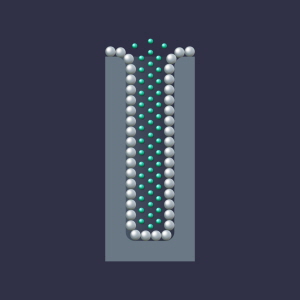램리서치가 3세대 극저온 유전체 식각 기술인 Lam Cryo™ 3.0을 통해 메모리 칩 제조사들이 목표로 하고 있는 2030년 1,000단 3D 낸드 양산을 실현하는데 적극 나선다.
유전체 공정比 2.5배 식각률, 0.1% 미만 프로파일 편차
새로운 식각가스 사용, 탄소배출량 최대 90% 까지 감축

램리서치가 양산성이 검증된 극저온 식각 기술을 통해 메모리 칩 제조사들이 목표로 하고 있는 2030년 1,000단 3D 낸드 양산을 실현하는데 적극 나선다.
램리서치는 3세대 극저온 유전체 식각 기술인 Lam Cryo™ 3.0을 출시했다고 1일 밝혔다.
Lam Cryo™ 3.0은 극저온의 공정 온도, 고출력 파워 고밀도 플라즈마 리액터 기술과 표면 화학의 혁신이 결합된 결과물로 업계 최고 수준의 정밀도와 프로파일 제어를 달성했다.
램리서치의 글로벌 제품 사업부 수석 부사장인 세샤 바라다라잔(Sesha Varadarajan)은 “Lam Cryo™ 3.0을 통해 우리는 고객들이 3D 낸드 1,000단 달성을 위해 필요한 길을 닦고 있다. 램리서치의 극저온 식각 장비를 통해 이미 500만장이 넘는 웨이퍼가 제조됐으며, 이번에 소개하는 최신 기술은 3D 낸드 생산에 있어 또 다른 혁신의 기점이다. 이 기술은 환경 영향을 줄이면서 기존 유전체 공정 대비 2.5배의 식각률을 달성하고, 옹스트롬(angstrom) 수준의 정밀도로 고종횡비 피처를 일정하게 구현한다. Lam Cryo™ 3.0은 고객사들이 AI 시대의 낸드 제조의 주요 난제를 극복하는데 필요한 식각 기술”이라고 강조했다.
오늘날까지 3D 낸드 스케일링은 주로 메모리 셀을 수직으로 적층하는 방식으로 이루어져 왔으며 이를 위해 깊고 좁게 파는 고종횡비 메모리 채널 식각 기술이 사용됐다.
이 과정에서 구조의 목표 프로파일에 원자 수준의 미세한 편차가 발생하면 소자의 전기적 특성은 물론 수율에까지 부정적인 영향을 미쳤다.
Lam Cryo™ 3.0은 스케일링에 있어서 이러한 문제를 포함한 식각 공정에서의 다양한 난제들을 극복하는데 최적화됐다.
글로벌 리서치 기업 카운터포인트리서치의 공동 설립자이자 연구 담당 부사장인 닐 샤(Neil Shah)는 “AI는 클라우드는 물론 엣지 컴퓨팅에서의 플래시 메모리 성능과 용량의 수요를 폭발적으로 증가시키고 있다. 이로 인해 칩 제조사들은 2030년까지 3D 낸드 1,000단 도달 경쟁에서 낸드 플래시를 확장하고 있다”고 설명했다.
또한 “이를 가능케 할 램리서치의 Lam Cryo™ 3.0은 기존의 한계를 뛰어넘는 혁신적인 기술이다. 채널폭의 50배가 넘는 깊은 메모리 채널을 거의 완벽에 가까운 정밀도와 제어로 식각함으로써 0.1% 미만의 프로파일 편차를 달성했다. 이 기술적 혁신은 첨단 3D 낸드의 수율과 전반적 성능을 크게 개선하고 AI 시대 칩 제조사들의 경쟁력을 강화시킬 것”이라고 강조했다.
Lam Cryo™ 3.0은 램 고유의 고출력 파워 고밀도 플라즈마 리액터와 공정 개선, 새로운 식각 가스 사용이 가능한 초저온 환경을 활용해 구현된다. 램리서치의 최신 Vantex® 유전체 시스템의 확장 가능한 고출력 펄스 플라즈마 기술과 결합 시 식각 깊이와 프로파일 제어가 크게 향상된다.
Lam Cryo™ 3.0사용으로 3D 낸드 제조사들은 상단부에서 하단부까지 구조의 임계치수 편차를 0.1% 미만으로 유지하며 최대 10마이크론(μm) 깊이의 메모리 채널을 식각할 수 있다.
그 외 주요 강점으로 기존 플라즈마 기술대비 2.5배 빠른 속도로 식각하면서도 비용효율성과 수율을 동시에 높일 수 있고, 웨이퍼당 에너지 소비를 40% 절감하고 새로운 식각 가스를 사용해 탄소 배출량을 최대 90%까지 감축하는 등 지속가능성 측면에서도 개선됐다.
또한 램의 최신 Vantex® 시스템에 적용할 수 있고, 주요 메모리 칩 제조사에서 사용되고 있는 기존 고종횡비 유전체 식각 장비 Flex® 포트폴리오에도 적용이 가능해 장비 투자 효율을 극대화 했다.
Lam Cryo™ 3.0에 대한 추가 정보는 웹사이트에서 확인 가능하다.
 램리서치가 양산성이 검증된 극저온 식각 기술을 통해 메모리 칩 제조사들이 목표로 하고 있는 2030년 1,000단 3D 낸드 양산을 실현하는데 적극 나선다.
램리서치가 양산성이 검증된 극저온 식각 기술을 통해 메모리 칩 제조사들이 목표로 하고 있는 2030년 1,000단 3D 낸드 양산을 실현하는데 적극 나선다.